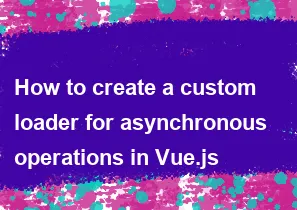How to create a custom loader for asynchronous operations in Vue.js

Creating a custom loader for asynchronous operations in Vue.js involves several steps. Here's a basic outline of how you can implement one:
Set Up Your Project: Make sure you have a Vue.js project set up with Vue CLI or any other preferred method.
Create a Loader Component: First, create a new Vue component for your loader. This component will be responsible for displaying the loader UI.
vue<!-- Loader.vue --> <template> <div v-if="isLoading" class="loader-container"> <!-- Your loader UI here --> <div class="loader"></div> </div> </template> <script> export default { data() { return { isLoading: false, }; }, }; </script> <style> /* Add your loader styles here */ .loader-container { position: fixed; top: 0; left: 0; width: 100%; height: 100%; background-color: rgba(0, 0, 0, 0.5); display: flex; justify-content: center; align-items: center; z-index: 9999; } .loader { /* Your loader styles */ } </style>Implement Loader Functionality: Add methods or computed properties to control the visibility of the loader.
vue<script> export default { data() { return { isLoading: false, }; }, methods: { async fetchData() { this.isLoading = true; try { // Perform asynchronous operation await this.$axios.get('your-api-endpoint'); } catch (error) { console.error(error); } finally { this.isLoading = false; } }, }, }; </script>Use the Loader Component: Import and use the loader component in your main layout or wherever you need it.
vue<template> <div id="app"> <!-- Other components and content --> <Loader /> </div> </template> <script> import Loader from './components/Loader.vue'; export default { components: { Loader, }, }; </script>Trigger Loader When Needed: Call the
fetchDatamethod (or any other method where you want to show the loader) from your components.vue<template> <div> <button @click="fetchData">Fetch Data</button> </div> </template> <script> export default { methods: { async fetchData() { this.$emit('show-loader'); try { // Perform asynchronous operation await this.$axios.get('your-api-endpoint'); } catch (error) { console.error(error); } finally { this.$emit('hide-loader'); } }, }, }; </script>
This is a basic example of how to create a custom loader for asynchronous operations in Vue.js. You can extend this further based on your specific requirements, such as adding animations, customization options, or handling different types of loading states.
-
Popular Post
- How to optimize for Google's About This Result feature for local businesses
- How to implement multi-language support in an Express.js application
- How to handle and optimize for changes in mobile search behavior
- How to handle CORS in a Node.js application
- How to use Vue.js with a UI framework (e.g., Vuetify, Element UI)
- How to configure Laravel Telescope for monitoring and profiling API requests
- How to create a command-line tool using the Commander.js library in Node.js
- How to implement code splitting in a React.js application
- How to use the AWS SDK for Node.js to interact with various AWS services
- How to use the Node.js Stream API for efficient data processing
- How to implement a cookie parser middleware in Node.js
- How to implement WebSockets for real-time communication in React
-
Latest Post
- How to implement a dynamic form with dynamic field styling based on user input in Next.js
- How to create a custom hook for handling user interactions with the browser's device motion in Next.js
- How to create a custom hook for handling user interactions with the browser's battery status in Next.js
- How to implement a dynamic form with dynamic field visibility based on user input in Next.js
- How to implement a dynamic form with real-time collaboration features in Next.js
- How to create a custom hook for handling user interactions with the browser's media devices in Next.js
- How to use the useSWRInfinite hook for paginating data with a custom loading indicator in Next.js
- How to create a custom hook for handling user interactions with the browser's network status in Next.js
- How to create a custom hook for handling user interactions with the browser's location in Next.js
- How to implement a dynamic form with multi-language support in Next.js
- How to create a custom hook for handling user interactions with the browser's ambient light sensor in Next.js
- How to use the useHover hook for creating interactive image zoom effects in Next.js